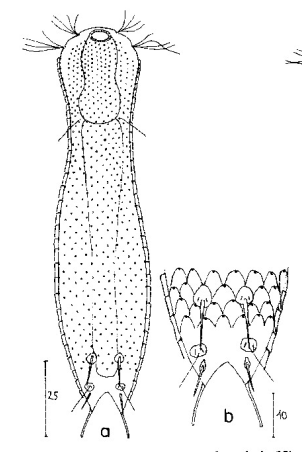Aspidiophorus
- Body bottle shaped
- Furka normal
- Peduncle scales
The genus Aspidiophorus is very easily recognized microscopically by the apparent “double contour” of the body. This double contour is produced by the typical style scales of this genus, which consist of a base plate that sits directly on the cuticle. From this base plate rises a thin peduncle, which carries at its end a - usually larger - un-spined terminal plate:
 typical scales of an Aspidiophorus, here A. squamulosus.
typical scales of an Aspidiophorus, here A. squamulosus.
This results in the typical double outer contour of the animals:

- Body bottle shaped
- Furka normal
- Peduncle scales
23 Species:

Aspidiophorus squamulosus
115 µm - 265 µmDorsal scales: 12-15 rows of 40-42 petiolar scales each with rhombic terminal plates without median keel (3-4 x 5-6 µm); scale shell ends in anal region; posterior end and toes naked; 3 pairs of short spines at base of toes (8-10 µm).
Ventral scales: 2 terminal keels (5-6 µm), 12 rows of keels without base plates
Particularities: Mouth armament pointed clasp

Aspidiophorus tatraensis
180 µmDorsal scales: 15-20 rows of 38-40 very small peduncle scales each; endplates very delicate and unkeeled (2.5-3 µm); strongly bent peduncles -> scales protrude like bristles
Ventral scales: Ventral intercilliary field 9-10 rows keels; anteriorly mostly naked; no terminal plates.
Particularities: protruding scales; body cylindrical

Aspidiophorus tetrachaetus
110 µm - 137 µmDorsal scales: 15-17 rows of 33-40 petiole scales each; end plates unkeeled 2-5µm, rounded distally and proximally; base of toes naked; 2 pairs of thick spines (8-10µm and 4-5µm) on oval scales with two keels.
Ventral scales: 2 terminal keels (7.5-11µm); in gut region 8-9 rows of tiny keels, otherwise naked
Particularities: 2 pairs of spines at the rear end